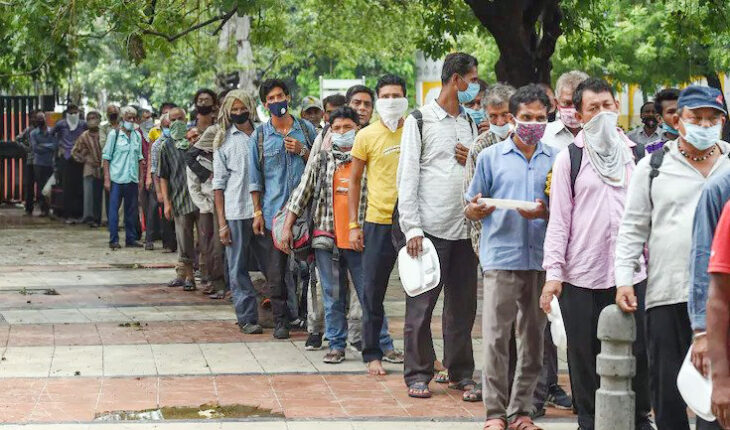NEW DELHI: India has the highest prevalence of wasted children under five years in the world, which reflects acute undernutrition, according to the Global Hunger Index 2020.
The situation has worsened in the 2015-19 period, when the prevalence of child wasting was 17.3%, in comparison to 2010-14, when it was 15.1%.
Overall, India ranks 94 out of 107 countries in the Index, lower than neighbours such as Bangladesh (75) and Pakistan (88). 2020 scores reflect data from 2015-19.
One positive in the report on India is the reduction in under-five mortality. However, this doesn’t mean the problem is over: “India—the region’s most populous country—experienced a decline in under-five mortality in this period, driven largely by decreases in deaths from birth asphyxia or trauma, neonatal infections, pneumonia, and diarrhea.
However, child mortality caused by prematurity and low birthweight increased, particularly in poorer states and rural areas. Prevention of prematurity and low birthweight is identified as a key factor with the potential to reduce under-five mortality in India, through actions such as better antenatal care, education, and nutrition as well as reductions in anemia and oral tobacco use,” the study recommends.
According to the 2020 GHI, no country that has been ranked falls in the “extremely alarming” category on hunger. Three countries – Chad, Timor-Leste and Madagascar – have come under the “alarming” category.
The Index, which was released on Friday, is a peer-reviewed report released annually by Concern Worldwide and Welthungerhilfe.
It uses four parameters to determine its scores. India fares worst in child wasting (low weight for height, reflecting acute undernutrition) and child stunting (low height for age, reflecting chronic undernutrition), which together make up a third of the total score. Although it is still in the poorest category, however, child stunting has actually improved significantly, from 54% in 2000 to less than 35% now. Child wasting, on the other hand, has not improved in the last two decades, and is rather worse than it was decade ago.
India has improved in both child mortality rates, which are now at 3.7%, and in terms of undernourishment, with about 14% of the total population which gets an insufficient caloric intake.
In the region of south, east and south-eastern Asia, the only countries which fare worse than India are Timor-Leste, Afghanistan and North Korea.
Globally, nearly 690 million people are undernourished, according to the report, which warns that the COVID-19 pandemic could have affected the progress made on reducing hunger and poverty.
“The world is not on track to achieve the second Sustainable Development Goal — known as Zero Hunger for short — by 2030. At the current pace, approximately 37 countries will fail even to reach low hunger, as defined by the Global Hunger Index Severity Scale, by 2030,” says the report. “These projections do not account for the impacts of the COVID-19 pandemic, which may worsen hunger and undernutrition in the near term and affect countries’ trajectories into the future … COVID-19 has made it clearer than ever that our food systems, as they stand, are inadequate to the task of achieving Zero
Hunger.”AGENCIES
Overall, India ranks 94 out of 107 countries in the Index, lower than neighbours such as Bangladesh (75) and Pakistan (88). 2020 scores reflect data from 2015-19.
One positive in the report on India is the reduction in under-five mortality. However, this doesn’t mean the problem is over: “India—the region’s most populous country—experienced a decline in under-five mortality in this period, driven largely by decreases in deaths from birth asphyxia or trauma, neonatal infections, pneumonia, and diarrhea.
However, child mortality caused by prematurity and low birthweight increased, particularly in poorer states and rural areas. Prevention of prematurity and low birthweight is identified as a key factor with the potential to reduce under-five mortality in India, through actions such as better antenatal care, education, and nutrition as well as reductions in anemia and oral tobacco use,” the study recommends.
According to the 2020 GHI, no country that has been ranked falls in the “extremely alarming” category on hunger. Three countries – Chad, Timor-Leste and Madagascar – have come under the “alarming” category.
The Index, which was released on Friday, is a peer-reviewed report released annually by Concern Worldwide and Welthungerhilfe.
It uses four parameters to determine its scores. India fares worst in child wasting (low weight for height, reflecting acute undernutrition) and child stunting (low height for age, reflecting chronic undernutrition), which together make up a third of the total score. Although it is still in the poorest category, however, child stunting has actually improved significantly, from 54% in 2000 to less than 35% now. Child wasting, on the other hand, has not improved in the last two decades, and is rather worse than it was decade ago.
India has improved in both child mortality rates, which are now at 3.7%, and in terms of undernourishment, with about 14% of the total population which gets an insufficient caloric intake.
In the region of south, east and south-eastern Asia, the only countries which fare worse than India are Timor-Leste, Afghanistan and North Korea.
Globally, nearly 690 million people are undernourished, according to the report, which warns that the COVID-19 pandemic could have affected the progress made on reducing hunger and poverty.
“The world is not on track to achieve the second Sustainable Development Goal — known as Zero Hunger for short — by 2030. At the current pace, approximately 37 countries will fail even to reach low hunger, as defined by the Global Hunger Index Severity Scale, by 2030,” says the report. “These projections do not account for the impacts of the COVID-19 pandemic, which may worsen hunger and undernutrition in the near term and affect countries’ trajectories into the future … COVID-19 has made it clearer than ever that our food systems, as they stand, are inadequate to the task of achieving Zero
Hunger.”AGENCIES





